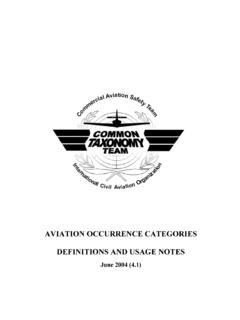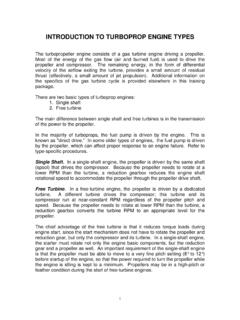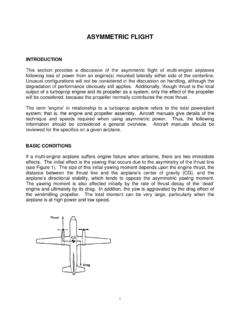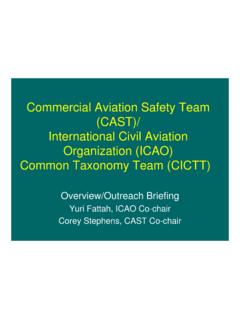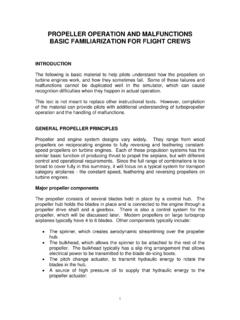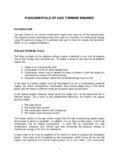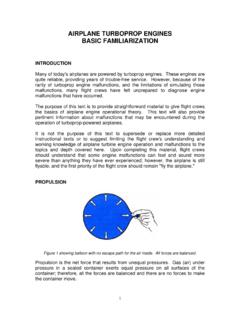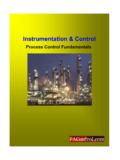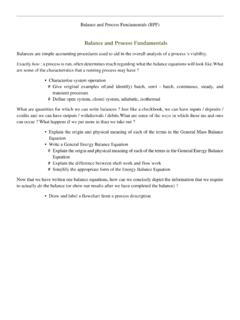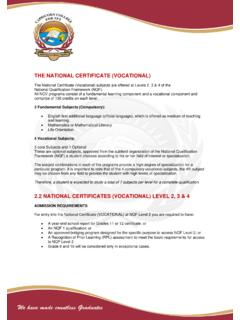Transcription of FUNDAMENTALS OF GAS TURBINE ENGINES - cast …
1 1 FUNDAMENTALS OF GAS TURBINE ENGINES INTRODUCTION The gas TURBINE is an internal combustion engine that uses air as the working fluid. The engine extracts chemical energy from fuel and converts it to mechanical energy using the gaseous energy of the working fluid (air) to drive the engine and propeller, which, in turn, propel the airplane. THE GAS TURBINE CYCLE The basic principle of the airplane TURBINE engine is identical to any and all ENGINES that extract energy from chemical fuel. The basic 4 steps for any internal combustion engine are: 1. Intake of air (and possibly fuel). 2. Compression of the air (and possibly fuel). 3. Combustion, where fuel is injected (if it was not drawn in with the intake air) and burned to convert the stored energy.
2 4. Expansion and exhaust, where the converted energy is put to use. In the case of a piston engine, such as the engine in a car or reciprocating airplane engine, the intake, compression, combustion, and exhaust steps occur in the same place (cylinder head) at different times as the piston goes up and down. In the TURBINE engine, however, these same four steps occur at the same time but in different places. As a result of this fundamental difference, the TURBINE has engine sections called: 1. The inlet section 2. The compressor section 3. The combustion section (the combustor) 4. The TURBINE (and exhaust) section. The TURBINE section of the gas TURBINE engine has the task of producing usable output shaft power to drive the propeller.
3 In addition, it must also provide power to drive the compressor and all engine accessories. It does this by expanding the high temperature, pressure, and velocity gas and converting the gaseous energy to mechanical energy in the form of shaft power. A large mass of air must be supplied to the TURBINE in order to produce the necessary power. This mass of air is supplied by the compressor, which draws the air into the engine and squeezes it to provide high-pressure air to the TURBINE . The compressor 2 does this by converting mechanical energy from the TURBINE to gaseous energy in the form of pressure and temperature. If the compressor and the TURBINE were 100% efficient, the compressor would supply all the air needed by the TURBINE .
4 At the same time, the TURBINE would supply the necessary power to drive the compressor. In this case, a perpetual motion machine would exist. However, frictional losses and mechanical system inefficiencies do not allow a perpetual motion machine to operate. Additional energy must be added to the air to accommodate for these losses. Power output is also desired from the engine (beyond simply driving the compressor); thus, even more energy must be added to the air to produce this excess power. Energy addition to the system is accomplished in the combustor. chemical energy from fuel as it is burned is converted to gaseous energy in the form of high temperatures and high velocity as the air passes through the combustor.
5 The gaseous energy is converted back to mechanical energy in the TURBINE , providing power to drive the compressor and the output shaft. SOME BASIC PRINCIPLES As air passes through a gas TURBINE engine, aerodynamic and energy requirements demand changes in the air s velocity and pressure. During compression, a rise in the air pressure is required, but not an increase in its velocity. After compression and combustion have heated the air, an increase in the velocity of gases is necessary in order for the TURBINE rotors to develop power. The size and shape of the ducts through which the air flows affect these various changes. Where a conversion from velocity to pressure is required, the passages are divergent.
6 Conversely, if a conversion from pressure to velocity is needed, a convergent duct is used. Before further discussion, an explanation of convergent ducts, divergent ducts, and the behavior of air within these ducts should be made. An understanding of the difference between static pressure (Ps), impact pressure, (Pi), and total pressure (Pt) is also needed. The difference between static, impact, and total pressures is as follows. Static pressure is the force per unit area exerted on the walls of a container by a stationary fluid. An example is the air pressure within a car tire. Impact pressure, on the other hand, is the force per unit area exerted by fluids in motion. Impact pressure is a function of the velocity of the fluid.
7 An example of impact pressure is the pressure exerted on one's hand held outside a moving car s window. Total pressure is the sum of static and impact pressures. Figure 2-1 illustrates the methods used to measure pressures. Part (a) illustrates the measurement of static pressure. Static pressure will not take into account the velocity of the air. Part (b) illustrates the measurement of total pressure, which accounts for both static pressure and the pressure due to the moving fluid (impact pressure). In 3 order to obtain impact pressure, the value of the static pressure is subtracted from the value of total pressure. Figure 2-2 shows the principle of divergent ducts, where energy is neither being added or taken away, but where the gaseous energy is being converted from velocity to pressure and temperature.
8 There is a velocity decrease as air flows from a small inlet to a larger outlet. As velocity decreases, impact pressure (Pi) also decreases. Since no energy is added or subtracted from the system, total pressure (Pt) for the air remains constant and static pressure (Ps) increases. One way of viewing this is that the impact pressure is converted to static pressure; thus, a static pressure rise is seen as air flows through a divergent duct and is compressed. A temperature rise is also noticed since compression is a heating process. The convergent duct operates exactly in reverse of the divergent duct. Figure 2-3 shows the principle of convergent ducts, where energy is neither being added or taken away, but where the gaseous energy is being converted from pressure and temperature to velocity.
9 There is a velocity increase as air flows from a large inlet to a smaller outlet. As velocity increases, impact pressure also increases. Since no energy is added or subtracted from the system, total pressure remains constant and static pressure decreases. One way of viewing this is that the static pressure is converted to impact pressure; thus, a static pressure decrease is seen as air flows through a convergent duct and goes through expansion. A temperature drop is associated with any expansion process. 4 NOTE: Even though the static and impact pressures are changing as fluids flow through either convergent or divergent ducts, the total pressure does not change.
10 This is true if fluid friction is neglected and energy is not added or taken away from the fluid flow. In actuality, there will be a slight decrease in total pressure because of fluid frictional losses. PERFORMANCE AND EFFICIENCY The type of operation for which the engine is designed dictates the performance requirement of a gas TURBINE engine. The performance requirement is mainly determined by the amount of shaft horsepower ( ) the engine develops for a given set of conditions. The majority of aircraft gas TURBINE ENGINES are rated at standard day conditions of 59 F and inches Hg. This provides a baseline to which gas TURBINE ENGINES of all types can be compared.
